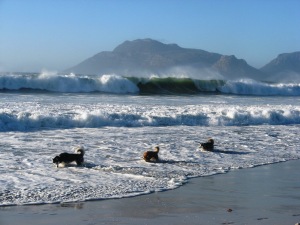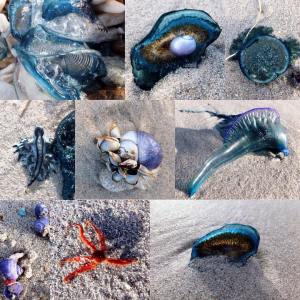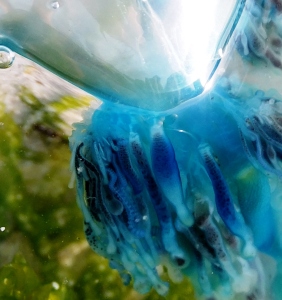There are so many thoughts, ideas and topics whizzing around in my head at the moment that I am having a tough time trying to pin only one down to work on. Considering the stormy weather that we are currently experiencing in this corner of the world, I have decided to start with the biological flotsam and jetsam that we regularly find along our shores. While the origins of the “Flotsam and Jetsam” phrase are seated in maritime law, wreckage/cargo that has been lost at sea and cargo/equipment that has been jettisoned while a craft is under way, it can be expanded to include all objects that hitch a ride on the ocean currents only to be regurgitated on to the first shore that they bump in to… essentially colourful, multi-textured ocean vomit! Due to the location of Long Beach, a stretch of white sand open to the ebb and flow of the Atlantic Ocean, washed up marine beasties are a common occurrence. This makes taking a wander along its shores a fascinating experience that is unique to each day, due to the ever-shifting environment in which it is situated. Below is a small collection of the species constituting a “Floating Blue Community” that can be encountered while beachcombing on our local shores.

Huge swells originating deep in the Southern Ocean are prevalent during the winter months dumping all manner of interesting findings along the coast.
Pleuston is the term given to organisms associated with the water surface; free-floating examples of this community include the by-the-wind sailor (Velella velella), purple storm snails (Janthina janthina), buoy barnacles (Dosima fascicularis) and Portuguese man o’ war (Physalia physalis). Strong winds associated with the winter storms in this region act to deposit vast amounts of these animals on various beaches along the Atlantic Seaboard. Check out this awesome close-up video of the Portuguese man o’ war. The commonly recognised form of the by-the-wind sailor is in fact the polyp life stage and is a hydroid colony constituting same sex polyps connected by a network of canals allowing the organism to share food and benefit from a greater protection. They use their nematocysts, stinging cells, to catch their prey and as with the other aforementioned creatures, these ocean sailors enjoy a pelagic lifestyle.

Sea swallow (Glaucus atlanticus) – A nudibranch species that feeds on the Portuguese man o’ war (and kin), using the stinging cells of this prey in its own defence.

Ventral surface of the sea swallow – those air bubbles are gulped by the organism to assist in buoyancy as it feeds upside down on the ocean surface.
Purple storm snails or bubble raft shells prey on both the by-the-wind sailors and Portuguese man o’ war and as a result often end up in the stranded community of invertebrates. All individuals begin life as male and later change to female. By trapping air bubbles with a layer of chitin, comparative to the protein keratin, they are able to maintain their position on the ocean surface but as a result they require reverse counter-shading as a form of “camouflage”.
Another pleustonic beastie that hangs upside down from the surface is the buoy barnacle and I think that the most interesting aspect of this species is that as an adult it can either attach itself to flotsam or construct its own float through a self-secreting cement. During its larval stage, however, individuals have to attach onto objects, which range from ram’s horn shell (Spirula spirula) and the by-the-wind sailors to driftwood and seaweeds, and as a fugitive species require colonising characteristics to survive. It is thought that the abundance of this species has been increasing in recent times as a result of the high levels of anthropogenic ocean junk littering our marine waters.
The resemblance of P. physalis to the Portuguese embodiment of the 18th century man-of-war at full sail forms the origin of its name and when under attack, they can deflate their gas-filled pneumatophore to submerge below the surface. These pneumatophores, or “sails”, either have a slight left or right orientation which is a particularly nifty way of ensuring that when the wind blows only a proportion of the population will end up stranding on the beach. Like the by-the-wind sailors, the man o’ war also uses nematocysts to trap its prey… familiar to beach goers and the source of the age old, albeit incorrect, tradition of urinating on a friend in a not-to-be-talked-about bonding session.
There are so many awesome creatures out there that if we just take the time to become aware of our surroundings, we can marvel in the “weird and wonderful” that Mother Nature has to offer us. Happy Beachcombing…

Onshore winds transform your local beach into a treasure trove of fascinating beasties, making an early morning walk after these winds the best time to explore!
Explore. Dream. Discover.
Branch GM, Griffiths CL, Branch ML & Beckley LE. 2010. Two Oceans: A Guide to the Marine Life of Southern Africa. Cape Town: Struik Nature.












Great first blog, looking forward to the next one 🙂
LikeLiked by 1 person
Thanks 🙂
LikeLike
Really cool Sal, also can’t wait for the next one 🙂
LikeLiked by 1 person
Thanks chickadee…working on it as we speak 😊
LikeLike
Thoroughly enjoyed this first edition of the ‘scientist in limbo’. Quirky, entertaining and informative. It’s got the ingredients to the perfect stew. The pictures are amaze-balls as always. 😄
LikeLiked by 1 person
Aw dude you so sweet! Thanks for the awesome words!
LikeLike
Pingback: Our Awesome Oceans | Scientist in Limbo
Pingback: A Common Yet Swift Antarctic Sandwich | Scientist in Limbo